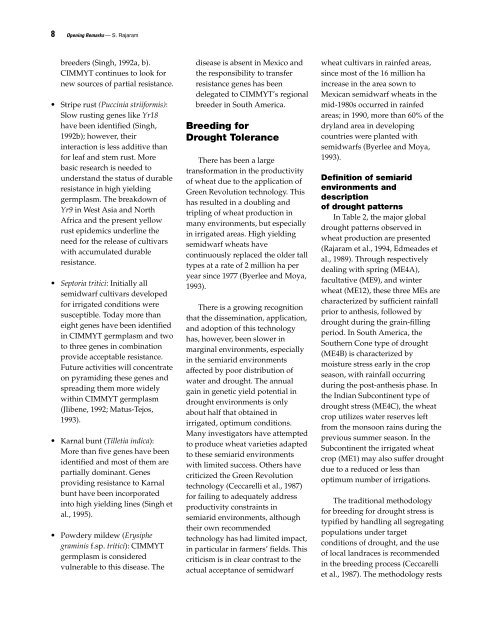Septoria and Stagonospora Diseases of Cereals - CIMMYT ...
Septoria and Stagonospora Diseases of Cereals - CIMMYT ...
Septoria and Stagonospora Diseases of Cereals - CIMMYT ...
You also want an ePaper? Increase the reach of your titles
YUMPU automatically turns print PDFs into web optimized ePapers that Google loves.
8 Opening Remarks — S. Rajaram<br />
breeders (Singh, 1992a, b).<br />
<strong>CIMMYT</strong> continues to look for<br />
new sources <strong>of</strong> partial resistance.<br />
• Stripe rust (Puccinia striiformis):<br />
Slow rusting genes like Yr18<br />
have been identified (Singh,<br />
1992b); however, their<br />
interaction is less additive than<br />
for leaf <strong>and</strong> stem rust. More<br />
basic research is needed to<br />
underst<strong>and</strong> the status <strong>of</strong> durable<br />
resistance in high yielding<br />
germplasm. The breakdown <strong>of</strong><br />
Yr9 in West Asia <strong>and</strong> North<br />
Africa <strong>and</strong> the present yellow<br />
rust epidemics underline the<br />
need for the release <strong>of</strong> cultivars<br />
with accumulated durable<br />
resistance.<br />
• <strong>Septoria</strong> tritici: Initially all<br />
semidwarf cultivars developed<br />
for irrigated conditions were<br />
susceptible. Today more than<br />
eight genes have been identified<br />
in <strong>CIMMYT</strong> germplasm <strong>and</strong> two<br />
to three genes in combination<br />
provide acceptable resistance.<br />
Future activities will concentrate<br />
on pyramiding these genes <strong>and</strong><br />
spreading them more widely<br />
within <strong>CIMMYT</strong> germplasm<br />
(Jlibene, 1992; Matus-Tejos,<br />
1993).<br />
• Karnal bunt (Tilletia indica):<br />
More than five genes have been<br />
identified <strong>and</strong> most <strong>of</strong> them are<br />
partially dominant. Genes<br />
providing resistance to Karnal<br />
bunt have been incorporated<br />
into high yielding lines (Singh et<br />
al., 1995).<br />
• Powdery mildew (Erysiphe<br />
graminis f.sp. tritici): <strong>CIMMYT</strong><br />
germplasm is considered<br />
vulnerable to this disease. The<br />
disease is absent in Mexico <strong>and</strong><br />
the responsibility to transfer<br />
resistance genes has been<br />
delegated to <strong>CIMMYT</strong>’s regional<br />
breeder in South America.<br />
Breeding for<br />
Drought Tolerance<br />
There has been a large<br />
transformation in the productivity<br />
<strong>of</strong> wheat due to the application <strong>of</strong><br />
Green Revolution technology. This<br />
has resulted in a doubling <strong>and</strong><br />
tripling <strong>of</strong> wheat production in<br />
many environments, but especially<br />
in irrigated areas. High yielding<br />
semidwarf wheats have<br />
continuously replaced the older tall<br />
types at a rate <strong>of</strong> 2 million ha per<br />
year since 1977 (Byerlee <strong>and</strong> Moya,<br />
1993).<br />
There is a growing recognition<br />
that the dissemination, application,<br />
<strong>and</strong> adoption <strong>of</strong> this technology<br />
has, however, been slower in<br />
marginal environments, especially<br />
in the semiarid environments<br />
affected by poor distribution <strong>of</strong><br />
water <strong>and</strong> drought. The annual<br />
gain in genetic yield potential in<br />
drought environments is only<br />
about half that obtained in<br />
irrigated, optimum conditions.<br />
Many investigators have attempted<br />
to produce wheat varieties adapted<br />
to these semiarid environments<br />
with limited success. Others have<br />
criticized the Green Revolution<br />
technology (Ceccarelli et al., 1987)<br />
for failing to adequately address<br />
productivity constraints in<br />
semiarid environments, although<br />
their own recommended<br />
technology has had limited impact,<br />
in particular in farmers’ fields. This<br />
criticism is in clear contrast to the<br />
actual acceptance <strong>of</strong> semidwarf<br />
wheat cultivars in rainfed areas,<br />
since most <strong>of</strong> the 16 million ha<br />
increase in the area sown to<br />
Mexican semidwarf wheats in the<br />
mid-1980s occurred in rainfed<br />
areas; in 1990, more than 60% <strong>of</strong> the<br />
dryl<strong>and</strong> area in developing<br />
countries were planted with<br />
semidwarfs (Byerlee <strong>and</strong> Moya,<br />
1993).<br />
Definition <strong>of</strong> semiarid<br />
environments <strong>and</strong><br />
description<br />
<strong>of</strong> drought patterns<br />
In Table 2, the major global<br />
drought patterns observed in<br />
wheat production are presented<br />
(Rajaram et al., 1994, Edmeades et<br />
al., 1989). Through respectively<br />
dealing with spring (ME4A),<br />
facultative (ME9), <strong>and</strong> winter<br />
wheat (ME12), these three MEs are<br />
characterized by sufficient rainfall<br />
prior to anthesis, followed by<br />
drought during the grain-filling<br />
period. In South America, the<br />
Southern Cone type <strong>of</strong> drought<br />
(ME4B) is characterized by<br />
moisture stress early in the crop<br />
season, with rainfall occurring<br />
during the post-anthesis phase. In<br />
the Indian Subcontinent type <strong>of</strong><br />
drought stress (ME4C), the wheat<br />
crop utilizes water reserves left<br />
from the monsoon rains during the<br />
previous summer season. In the<br />
Subcontinent the irrigated wheat<br />
crop (ME1) may also suffer drought<br />
due to a reduced or less than<br />
optimum number <strong>of</strong> irrigations.<br />
The traditional methodology<br />
for breeding for drought stress is<br />
typified by h<strong>and</strong>ling all segregating<br />
populations under target<br />
conditions <strong>of</strong> drought, <strong>and</strong> the use<br />
<strong>of</strong> local l<strong>and</strong>races is recommended<br />
in the breeding process (Ceccarelli<br />
et al., 1987). The methodology rests









